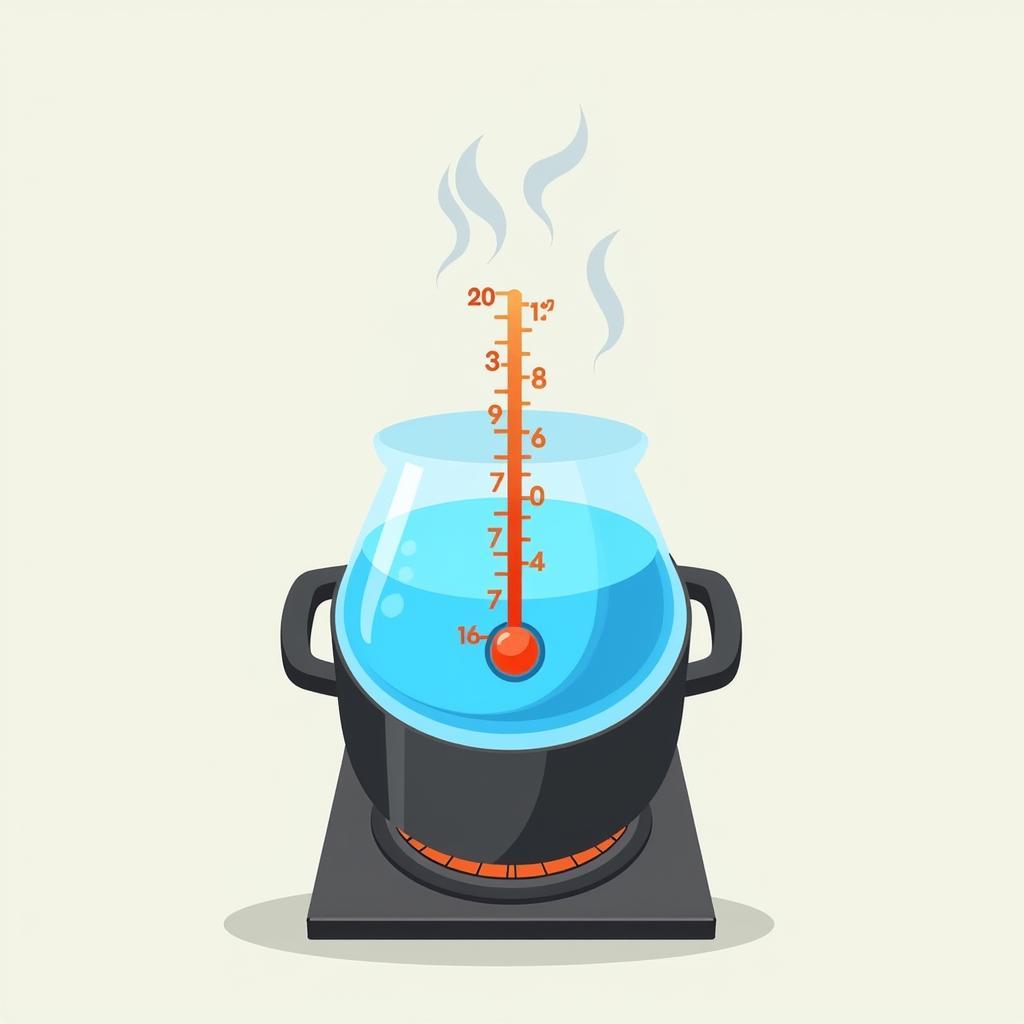Heat capacity and latent heat are two crucial concepts in thermodynamics that often cause confusion. They both relate to the thermal energy of a substance, but they describe different aspects of how that energy interacts with the matter. This article will delve into the differences between heat capacity and latent heat, providing clear explanations and real-world examples.
What is Heat Capacity?
Heat capacity is the amount of heat energy required to raise the temperature of a substance by one degree Celsius (or one Kelvin). It represents the ability of a substance to store thermal energy. A higher heat capacity means the substance can absorb more heat without a significant temperature change. Think of a large pot of water on the stove; it takes a considerable amount of heat to bring it to a boil because water has a relatively high heat capacity.
Different materials have different heat capacities. For instance, metals generally have lower heat capacities than water, meaning they heat up and cool down faster. This is why a metal spoon left in a hot cup of coffee will quickly become too hot to touch, while the coffee itself cools down more slowly.
 Nhiệt dung của nước
Nhiệt dung của nước
What is Latent Heat?
Latent heat, on the other hand, is the amount of heat energy required to change the state of a substance without changing its temperature. This means that during a phase change, such as melting ice or boiling water, the temperature remains constant even though heat is being added or removed. The “latent” in latent heat refers to the fact that this heat is “hidden” in the sense that it doesn’t cause a temperature change.
There are two main types of latent heat: latent heat of fusion and latent heat of vaporization. Latent heat of fusion is the energy needed to change a substance from solid to liquid (melting) or liquid to solid (freezing) at its melting point. Latent heat of vaporization is the energy needed to change a substance from liquid to gas (vaporization) or gas to liquid (condensation) at its boiling point.
 Nhiệt ẩn của nước đá
Nhiệt ẩn của nước đá
Heat Capacity vs Latent Heat: Key Differences
The key difference between heat capacity and latent heat lies in what happens to the temperature during the heat transfer. Heat capacity is associated with temperature changes, while latent heat is associated with phase changes at a constant temperature.
Comparing Heat Capacity and Latent Heat
| Feature | Heat Capacity | Latent Heat |
|---|---|---|
| Temperature | Changes with heat transfer | Remains constant during phase change |
| State of Matter | Substance remains in the same state | Substance changes state (solid, liquid, gas) |
| Application | Calculating temperature change upon heating/cooling | Calculating energy needed for phase transitions |
 So sánh nhiệt dung và nhiệt ẩn
So sánh nhiệt dung và nhiệt ẩn
Real-World Applications
Understanding heat capacity and latent heat is essential in numerous fields. For example, engineers use these concepts to design heating and cooling systems, while meteorologists use them to understand weather patterns. In cooking, knowing the heat capacity of different ingredients helps determine cooking times, and understanding latent heat explains why steam burns are more severe than hot water burns.
“Understanding the difference between heat capacity and latent heat is fundamental in thermodynamics. It allows us to accurately predict and control thermal processes in various applications,” says Professor Nguyen Van A, a leading expert in thermodynamics at the Hanoi University of Science and Technology.
Conclusion
Heat capacity and latent heat are distinct but related concepts that describe how matter interacts with thermal energy. Heat capacity describes the ability of a substance to store heat and change temperature, while latent heat describes the energy required for phase changes at a constant temperature. Understanding the difference between heat capacity and latent heat is crucial for a deeper comprehension of thermodynamics and its applications in various fields.
“Ignoring the distinction between heat capacity and latent heat can lead to miscalculations and inefficient designs in engineering applications,” adds Dr. Tran Thi B, a renowned researcher in thermal engineering.
FAQ
-
What are the units of heat capacity?
- The units of heat capacity are typically Joules per degree Celsius (J/°C) or Joules per Kelvin (J/K).
-
What are the units of latent heat?
- The units of latent heat are typically Joules per kilogram (J/kg) or Joules per mole (J/mol).
-
Why does the temperature remain constant during a phase change?
- The added heat energy during a phase change is used to break or form intermolecular bonds, rather than increasing the kinetic energy of the molecules (which would result in a temperature change).
-
Does the heat capacity of a substance change with temperature?
- Yes, the heat capacity of a substance can vary slightly with temperature.
-
Which has a higher latent heat of vaporization, water or alcohol?
- Water generally has a higher latent heat of vaporization than alcohol.
-
Why is understanding heat capacity important in cooking?
- Knowing the heat capacity helps determine how quickly a food item will heat up or cool down, influencing cooking times and temperatures.
-
How does latent heat play a role in weather patterns?
- Latent heat released during condensation in clouds plays a significant role in driving atmospheric circulation and weather patterns.
Gợi ý các câu hỏi khác, bài viết khác có trong web.
- Sự khác biệt giữa nhiệt và nhiệt độ là gì?
- Định luật nhiệt động lực học là gì?
- Ứng dụng của nhiệt động lực học trong đời sống?